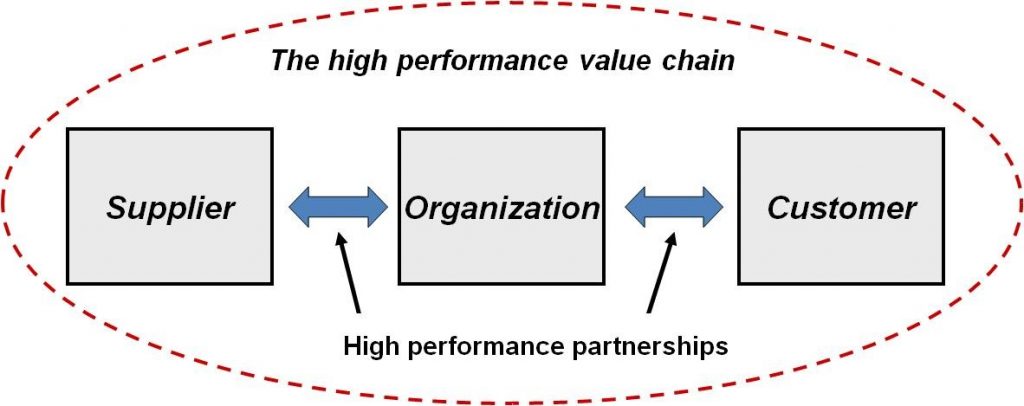Nowadays it is rare to find an organization that operates in confinement without the need to deal or partner with other organizations in a form of ‘inter-organizational cooperation’. In fact, in most markets, partnerships between firms are needed for them to realize competitive advantage. Partnerships offer firms access to new technologies, new markets, a wider range of products and services, new knowledge, and economies of scale. When an organization is in the process of transforming itself into a high performance organization (HPO), it usually focuses on strengthening its internal operations and processes. However, during and after the transformation this organization will find itself operating within a bigger value chain whose performance potentially has a big impact on the performance of the organization itself. The quality of the complete value chain denotes the ultimate outcome of an organization’s efforts. Thus, if one of the partners in the value chain delivers poor quality, the end customer will be negatively affected despite the efforts of the other organizations in the value chain. Therefore, it is important that not only the individual organization but also its partners in the value chain all perform at the highest quality level; and that the links between these partners are of equally high quality. Meaning the links in the value chain also need to improve to a level of a high performance partnership (HPP), which is defined as “a tailored business relationship based on mutual trust, openness, shared risks and shared rewards that yields a competitive advantage, resulting in business performance greater than would be achieved by the firms individually and which is greater than that of other partnerships in the same industry”. Figure 1 depicts the relationships in an HPP.
Figure 1: The relationships in an HPP
So the real brave and bold organisation goes where few organisations have gone better: it often already starts building an HPP with its main suppliers and clients during the transformation to HPO. So far we have advised organisations in the Netherlands, Philippines, Egypt and the UK in their efforts to create this type of partnerships. We have found that there are ten factors which are the foundation of each HPP:
- Closeness. Creating strong interpersonal relationships between the partners with regular, open and honest, face-to-face physical communication and high levels of interaction to ensure adequacy, completeness, credibility, and accuracy of information exchanged.
- Commitment. Having an interest in the partnership relation and therefore readiness to develop a long-term partnership through sharing responsibilities, risk, power and accountabilities.
- Communication. Consists of high quality of information, effective information sharing, high levels of participation in the communication by all partners, and quick responses to changing partner and customer needs.
- Conflict handling. Collaboratively preventing and solving any emerging conflicts in the partnership through techniques like constant feedback, mutual evaluation of performance, and creating a balance of power between all partners.
- Control. There are two types of control: formal control, representing high levels of output and process control like formal contracts; and informal control, consisting of informal organizational cultures and systems that have an impact on the relationship between and the behaviour of parties, such as norms and values of the organizational culture.
- Coordination. The management of vital organizational activities, measured by the extent to which partners and their processes are mutually integrated to reduce uncertainties and improve the collaboration and performance.
- Dependence. Equality between the partners in terms of investments and resources, interests, decision power, organizational characteristics and abilities.
- Diversity. Diversity, caused by differences in norms, values, customs and backgrounds, is acknowledged and valued, and people in the partnership have cultural awareness and appreciate cultural differences.
- Management quality. Managers of each partner manage the partnership pro-actively and are all focused on achieving the mutual goals of the partners and achieving the desired partnership results.
- Trust. Trust needs time to be built and it is a prerequisite for smooth communication, knowledge exchange and continuous improvement in the partnership. Trust is a determinant of the future direction of the relationship.
The interesting thing is that when all parties in the value chain fill in the HPP Questionnaire (which is based on the ten factors), the outcome will be a slightly different set of HPP factors for each value chain that will help the parties in that value chain to become HPP-partners. It then takes great dedication, focus and willingness to cooperate to create the desired HPP state. But the reward is accordingly: partners are experiencing now better relations with each other, less problems and quality issues, and higher profits for all parties involved. Who wouldn’t want this?
More information: High Performance Partnership Diagnosis
